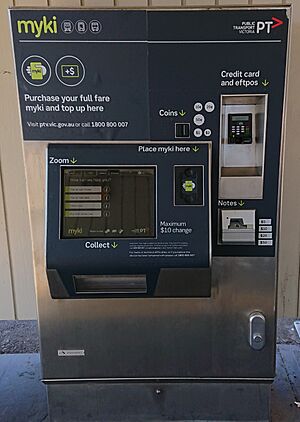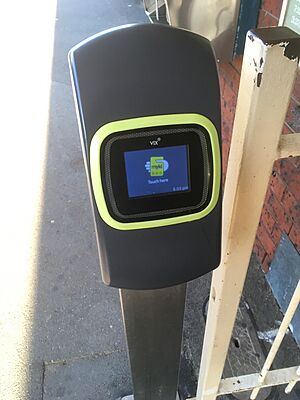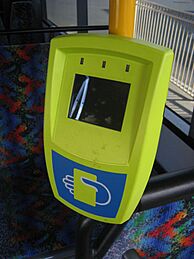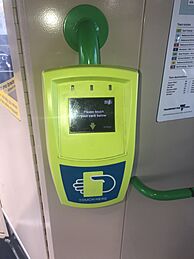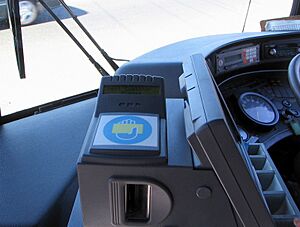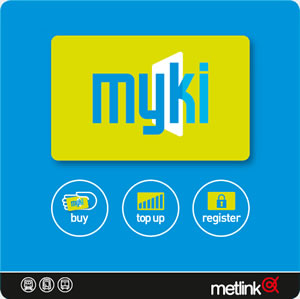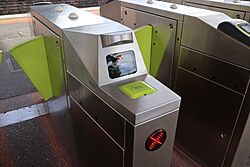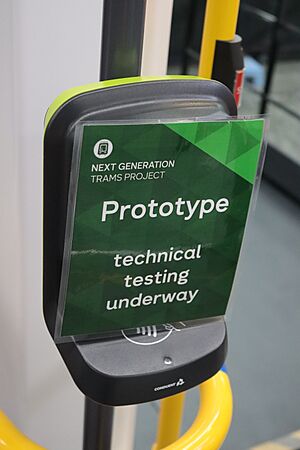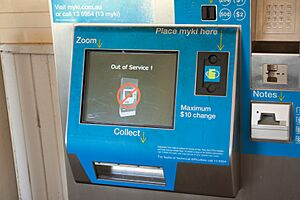Myki facts for kids
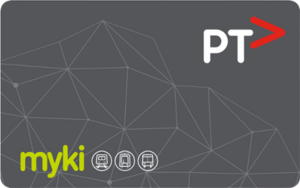
Physical Myki card
|
|
| Location | Victoria, Australia |
|---|---|
| Launched | 2008 |
| Predecessor | Metcard |
| Technology |
|
| Operator | Conduent (current) NTT Data (previously) |
| Manager | Public Transport Victoria |
| Currency | AUD |
| Stored-value | Myki money |
| Credit expiry | Does not expire (Card expires after 4 years but balance is transferable) |
| Auto recharge | Auto top-up |
| Unlimited use | Myki pass (for 7 days or between 28 and 365 days) |
| Validity |
|
| Retailed |
|
| Variants |
|
Myki (pronounced MY-kee) is a special reloadable card used to pay for public transport in Melbourne and other parts of Victoria, Australia. It's like a credit card but for trains, trams, and buses! Myki replaced an older system called Metcard and started working fully by the end of 2012.
This system was created by a group called Kamco and is managed by Public Transport Victoria. The first contract for Myki was very large, costing about A$1.5 billion. In 2016, the contract was extended for another seven years.
The original agreement for Myki ended in November 2023. In May 2023, the Victorian government announced a new contract with an American company called Conduent. This company now manages the Myki system for the next 15 years. The new system was planned to be fully ready by 2025, but in May 2025, the upgrade was delayed by 18 months.
How to Use Myki
Myki is easy to use for your travels. You can buy a Myki card and add money to it. This money is called "Myki money."
Getting and Topping Up Your Myki
You can buy a Myki smartcard at many places. These include ticket offices at train stations, Myki machines at stations and major bus/tram stops, the PTV Hub at Southern Cross railway station, and shops with a Myki sign (like most 7-Eleven stores). You can also buy one online or by phone. You cannot buy Myki cards on trams or buses. A full-fare card costs $6, and a child or concession card costs $3.
After you get your Myki, you need to add money to it. This is called "topping up." You can top up at the same places where you buy a card. You can also set up "auto top-up." This automatically adds money from your bank account or credit card when your Myki money gets low. You can also top up using the PTV app.
Touching On and Off
To use your Myki, you hold it against a Myki reader. This is called "touching on." You touch on at the start of your trip. At the end of your trip, you usually "touch off." The Myki system then figures out the correct fare and takes the money from your card.
If you don't have enough Myki money for a trip, your card might show a negative balance. You won't be able to touch on again until you top up your card to a positive amount.
For tram trips completely within Melbourne's "Free Tram Zone" (which covers most of the city centre), you do not need to touch on or off.
Mobile Myki
You can also use a "Mobile Myki" on an Android phone with Google Wallet. It works just like a physical Myki card. You hold your phone against a Myki reader to touch on or off. Remember, Mobile Myki cards need to be registered, just like regular Myki cards. Mobile Myki is not yet available on iPhones.
Where You Can Use Myki
You can use your Myki card for travel on:
- Melbourne's metropolitan train, tram, and bus services. This includes SmartBus services. (But not Skybus services).
- V/Line trains that travel within the commuter belt. This is the area between Southern Cross (Melbourne) and stations like Seymour, Traralgon, Wendouree, Waurn Ponds, and Goornong/Raywood.
- Regional buses in larger towns within the commuter belt. Examples include Ballarat, Bendigo, Geelong, and the Latrobe Valley.
Myki Card Types
Myki cards come in different types for different passengers. There are cards for full fare, concession, child, and Victorian seniors.
Myki cards used to have different designs and colours. After a redesign in late 2014, most Myki cards now have a grey/black design. This means you can't easily tell the difference between a full fare and a concession card just by looking at it.
There's also a "Myki Explorer" pack. This is great for visitors from other states or countries. A full fare pack costs $16 and includes a Myki card with $10 already on it. Child, concession, and seniors packs cost $8 and come with $5 credit. These packs also include discount vouchers for tourist attractions, instructions, and a Myki wallet. You can get back any unused money on the card when you're done with it. These packs are sold at places like Melbourne Airport, hotels, and tourist centres.
In May 2025, it was announced that a "youth Myki" is planned to start on January 1, 2026. This will allow people under 18 years old to travel for free on Victorian public transport. This new scheme is expected to replace the student pass for school students.
Registering Your Myki Card
You can "register" your Myki card or Mobile Myki with Public Transport Victoria (PTV). Registering your card is a good idea because it protects your money if your card is lost. It also lets you see your travel history online and set up auto top-up. PTV can also contact you if your card is about to expire.
How Fares Are Calculated
Myki uses a system based on "zones." Melbourne is divided into two zones (Zones 1 and 2). Outside Melbourne, there are more zones (Zones 3–16). Some areas are in overlapping zones.
The Myki system always tries to charge you the cheapest fare for your trip. Fares are based on how long you travel (a two-hour fare or a daily fare) and which zones you travel through. You can also buy a Myki pass for longer periods, like 7 days or 28 to 365 days. A Myki pass gives you unlimited travel within chosen zones for that time. If you buy a 365-day pass, you get some days free!
If you forget to touch off at the end of your journey, the system will charge you a "default fare." This is usually the most expensive trip you could have taken from where you touched on. You don't need to touch off if you're only travelling by tram within Zone 2.
After the 2022 Victorian state election, a daily fare cap was introduced. This means that no matter how many zones you travel through, the most you'll pay in a day is the same as a Zone 1+2 fare. This change was made to encourage more people to use public transport.
Myki Card Expiry
Myki cards have an expiry date, but it's not printed on the card. A physical card expires four years after you buy it. Mobile Myki expires after two years. If your card is registered, you can check its expiry date online. PTV will also remind you if your registered card is about to expire. If your card is not registered, you can check the expiry date at a Myki vending machine or Myki Check machine.
If your Myki card has expired or is expiring soon (within 60 days), you can get a new one for free. You can do this at staffed train stations, Myki-enabled V/Line stations, or a PTV Hub. Any money on your old card will be moved to your new card right away. You can also mail your expired card to PTV and wait for a new one. If your old card was registered, the new one will be registered automatically.
Myki History
Myki replaced the Metcard system in Melbourne and other ticketing systems used by buses in some regional cities. Work on Myki started in late 2002. In 2005, the Kamco group was chosen to develop the system. It was supposed to be finished by 2007.
There were some delays. A trial program started in Geelong in late 2007. In December 2008, Myki was first sold to the public on some bus routes in Geelong. By April 2009, all bus services in Ballarat, Bendigo, and Seymour were using Myki.
Melbourne Roll-out
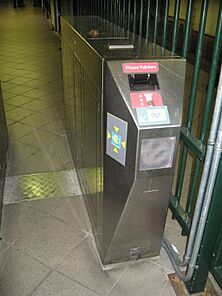
Myki readers started being installed in Melbourne in July 2007. Myki became valid for trains in Melbourne from December 29, 2009. In July 2010, Myki was also accepted on Melbourne's buses and trams.
During 2012, the Metcard system was slowly turned off. By the end of 2012, Myki became the only valid ticket for public transport in Melbourne.
In May 2014, the first Myki electronic gates with touch screens started working.
Regional Use
Myki started being used on regional "commuter" train services in July 2013. This happened in stages for different lines, like the Seymour, Traralgon, Bendigo, Ballarat, and Geelong lines.
In February 2014, paper tickets for V/Line commuter services were stopped. Passengers had to use Myki. Paper tickets are still used for travel outside the Myki zone, like to Warrnambool or Albury.
Changes During the COVID-19 Pandemic
The COVID-19 pandemic caused some changes to Myki. For example, from July 2021, you could no longer top up your Myki on buses. This was to encourage people to use the PTV app instead.
There were also some temporary fare changes. For a while in 2021, you could get a 30% discount for off-peak travel (trips made between 9:30 am and 4 pm or after 7 pm on weekdays). This was to help reduce crowds during busy times. Vouchers were also given out for free public transport days to encourage people to visit the city.
New Operator
In May 2023, it was announced that Conduent, a US ticketing company, would take over Myki from NTT Data. This new contract is for 15 years and is worth A$1.7 billion. The change happened on December 1, 2023.
New features are being added as part of this change. These include being able to pay with credit and debit cards. The system is also moving to an "account-based" system, and Myki will be expanded to regional areas that still use paper tickets. Trials with credit and debit cards started in November 2024 on buses in Wangaratta. New readers are being rolled out from May 2025 onwards.
Myki Issues and Criticisms
Over the years, Myki has faced some criticism:
- Cost and Delays: The system cost a lot of money ($1.5 billion) and took longer to be fully ready than planned.
- No Short-Term Tickets: Unlike many other cities, Myki doesn't offer short-term tickets for visitors or people who only travel sometimes.
- No Sales on Trams/Buses: You can't buy or top up a Myki card directly on trams or buses. You need to do it before you board. This can be tricky, especially in outer suburbs or late at night.
- Privacy Concerns: Some people worried about the amount of data Myki collected about passengers' travel.
- Forgetting to Touch Off: If you forget to touch off, you might be charged a higher "default fare."
- Faulty Machines: In the early days, some Myki machines were out of order or damaged by vandals.
- Card Problems: Sometimes, cards had issues like showing a very large negative balance. However, now you can easily replace a faulty Myki card at a staffed station.
See also
- List of smart cards
- Opal card – Sydney's smartcard ticketing system
- Translink go card – South East Queensland’s smartcard system
- SmartRider – Perth's smartcard system
- MetroCARD – Adelaide's smartcard system


